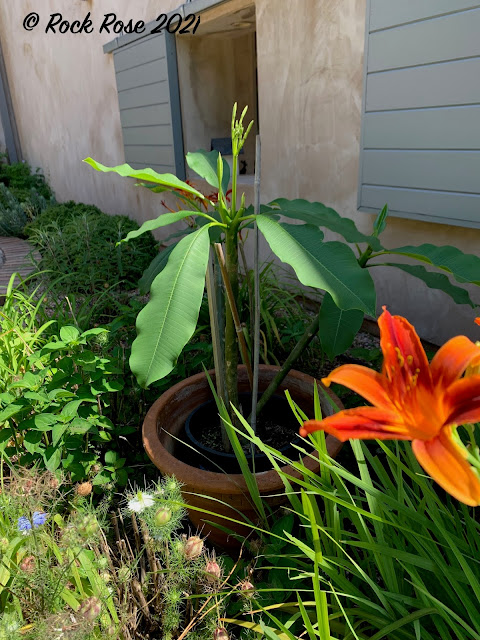I don't even have enough time to deal with everything in my inside gardens and outside gardens without venturing onto the septic field. But about 4 years go I decided I really wanted to have that wildflower meadow I should have had 21 years ago. That was when I bought a Texas wildflower and grass meadow mix from Native American seed. It was to go in the tank when they sprayed the cover on the septic field. When I came over the next day there sat the 2 bags by the garage, unopened. There was nothing in their spray tank but left over Bermuda which is what began to take hold within weeks. We tried to get rid of it and then put down our seed but it was to no avail. Weeds came and in the end David just decided to mow. It looked fine. Still I had that hankering to have the meadow. Five years ago David began mowing and collecting, the idea being to reduce the fertility of the soil. No more mulch mowing. I scattered left over bluebonnet seeds from the garden as well as blanket flowers.
Bluebonnets are now gone, but a year ago native bee balm, Monarda citriodora, started to grow and has really increased in numbers this year. I am so happy to have the purple one because at the top of the lot, near the road there are some white ones. This is hands dwon my favorite after the bluebonnet whihc is good because they don't share the same season.
And they are not called bee balm for nothing.
While I control the pink evening primrose, Oenothera speciosa, in my inside gardens, I am more than happy for it to spread outside.
And prairie verbena, Glandularia bipinnatifida, is a welcome plant.
Coreopsis, Coreopsis tinctoria, has started to bloom. Small plants at the moment but I am hoping next year their see will spread just as it does along the roadsides.
And this rather unusual one has popped up.
Tall vervain
Surprisingly the blanket flowers, Gaillardia grandiflora, struggle to survive as the they seem to be a favorite of the deer.
The first year we made a path alongside the septic field we had an amazing showing of Mexican hats, Ratibida columnifera. They were all different shades of yellow and brown. Some solid some mixed colors. Maybe the conditions were just perfect, never to be repeated. But one or two this year. All the yellow variety.
Horse herb or straggler daisy, Calyptocarpus vialis, soveres much of the shady area of the field but is nmaking headroads into the center. Maybe due to long days of rain and cloud. I think it will go dormant now we are well into summer temperatures.
And it is no surprise that our native lantana, Lantana urticoides. I will be watching out for the pink variety Lantana camara, which is invasive.
This year finds me very happy about how the wildflower meadow is coming along. And we haven't had to mow yet. That will be done in the fall.




























